Key takeaways:
- Understanding homelessness involves recognizing the personal stories and struggles of individuals, emphasizing the need for empathy and connection.
- Building community connections within shelters fosters an environment of support, encourages recovery, and allows individuals to share resources and mutual aid.
- Engagement with homeless individuals requires patience, active listening, and creating inviting atmospheres to facilitate genuine interactions and shared experiences.
- Sharing personal stories within the community strengthens bonds, fosters empathy, and encourages healing through vulnerability and connection.

Understanding homelessness charity
Homelessness charity goes beyond just providing food or shelter; it’s about fostering a sense of community and belonging. I remember volunteering at a local shelter where I met a man named David. Listening to his story made me realize that the journey through homelessness is often tangled with personal loss and isolation—issues that a simple meal can’t fix.
Consider what it means to truly understand the complexities of homelessness. Each individual carries their own history, full of dreams and disappointments. One evening at the shelter, while sharing coffee, a woman opened up about her struggles with mental health, which had contributed to her situation. It hit me then: addressing homelessness isn’t just about addressing physical needs; it’s about nurturing hope and healing.
When we talk about understanding homelessness charity, we should reflect on our own perceptions. Have you ever wondered what it feels like to be overlooked simply because of your circumstances? Engaging with those experiencing homelessness reveals their resilience and humanity, reminding us that charity isn’t merely a transaction; it’s a bridge to connection and empathy.
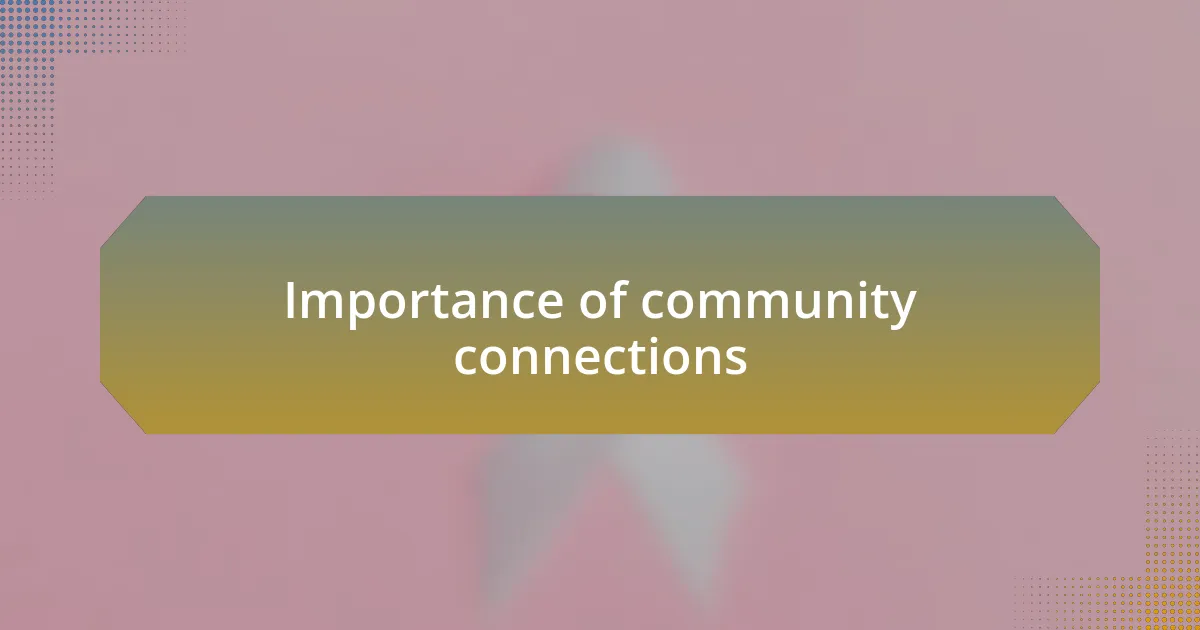
Importance of community connections
The strength of community connections in shelters cannot be overstated. I recall a night when I watched volunteers group together to organize a talent show for residents. The laughter, applause, and shared moments forged bonds that went well beyond the four walls of the shelter; they created an environment where people felt valued and seen. Have you ever experienced the joy of simply being part of something bigger than yourself?
Building connections can lay the groundwork for recovery and support systems. One memorable evening, I saw a former resident coaching others in a group discussion. The mutual support they provided was extraordinary, fostering an atmosphere of empowerment and trust. This experience made me reflect on how interpersonal relationships can act as a lifeline—encouraging individuals to confront their challenges with a network cheering them on.
Community connections also serve as a vital source for resource sharing and mutual aid. I met individuals who, despite their own difficulties, were willing to lend a hand to others. It made me question: why do we often underestimate the capacity for kindness and generosity in those who are struggling? Witnessing this spirit of giving, even in the direst circumstances, truly highlighted how these connections help in rebuilding lives, one relationship at a time.

Identifying local shelters
When I began my journey of connecting with local shelters, I quickly realized that identifying these spaces was the first crucial step. One evening, I walked through my neighborhood and stumbled upon a small building tucked between two bustling shops. The handwritten sign out front promised warmth and support, drawing me in to discover a community waiting to be nurtured. How many hidden gems are out there, just waiting for someone to shine a light on them?
In my search, I found that not all shelters are created equal. Some focus on immediate housing, while others offer supportive services like job training or mental health resources. It was fascinating to hear stories from the staff when I visited. They shared how their shelter uniquely catered to its residents, creating a tailored approach to meet diverse needs. Have you ever taken the time to learn about the specific services a shelter offers? That understanding deepened my appreciation for each place I encountered.
I’ve learned that reaching out to local organizations, like churches or community centers, can also lead to shelter referrals. Once, I attended a community meeting where a passionate advocate spoke about the power of local networks. I left inspired, ready to explore these connections further. Finding shelters isn’t just about a physical location—it’s about connecting with the heart of the community. Are you ready to embark on this journey, too?
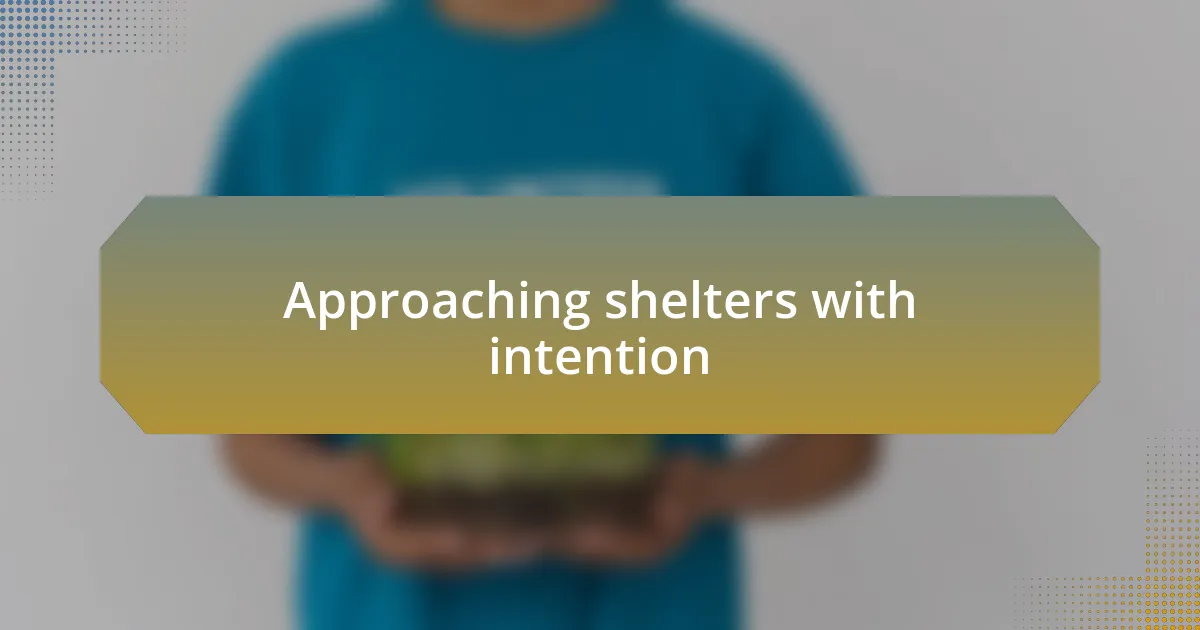
Approaching shelters with intention
When I think about approaching shelters, the importance of intention becomes crystal clear. On one occasion, I decided to volunteer at a local shelter, not just to lend a hand, but to truly engage with the people there. I remember sitting down with a few residents, listening to their stories, and realizing how that genuine interaction created a bridge of trust. Aren’t we all looking for connections that go beyond mere surface interactions?
As I visited different shelters, I made it a point to understand their mission and values. This deeper understanding informed my approach, allowing me to connect authentically with staff and volunteers. I recall one particularly moving conversation with a shelter director who described the daily challenges they faced. It struck me how much passion she poured into her work and how vital it was for me to show my appreciation for that effort. Isn’t it essential to recognize the commitment of those who dedicate their lives to helping others?
My experiences taught me that showing up with clear, respectful intentions can transform both my perspective and the shelter’s environment. Once, I brought in some homemade meals to share, and it was astounding to see how a small act of kindness could uplift spirits and inspire conversation. Have you ever considered how your presence and intentions could resonate with those who are often overlooked?
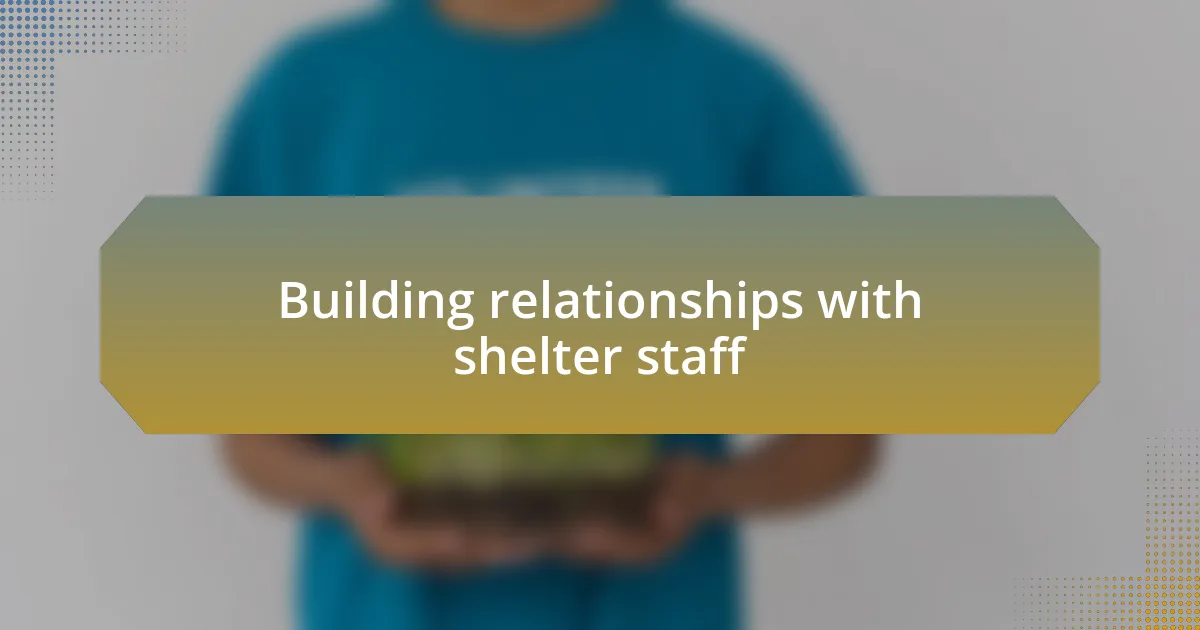
Building relationships with shelter staff
Establishing trust with shelter staff starts with genuine communication. I remember my first day volunteering; I approached the staff not just as a helper but as a colleague. When I asked about their work, their eyes lit up as they shared their experiences. That moment reminded me that asking questions can break down barriers and pave the way for meaningful relationships.
Sometimes, it’s the little things that make a significant difference. I once brought in a few coffee supplies for the staff, knowing how exhausting their shifts could be. It wasn’t just about the coffee; it was about acknowledging their hard work and creating a casual space for conversations. These small gestures can lead to candid discussions, helping build a supportive network within the shelter environment.
I’ve learned that being consistent is crucial in fostering these relationships. When I returned regularly, the staff began to see me as part of their community rather than just a temporary visitor. Have you ever thought about how consistency could change the dynamics of your interactions? That ongoing presence can cultivate mutual respect and camaraderie, making the shelter a more welcoming place for everyone involved.
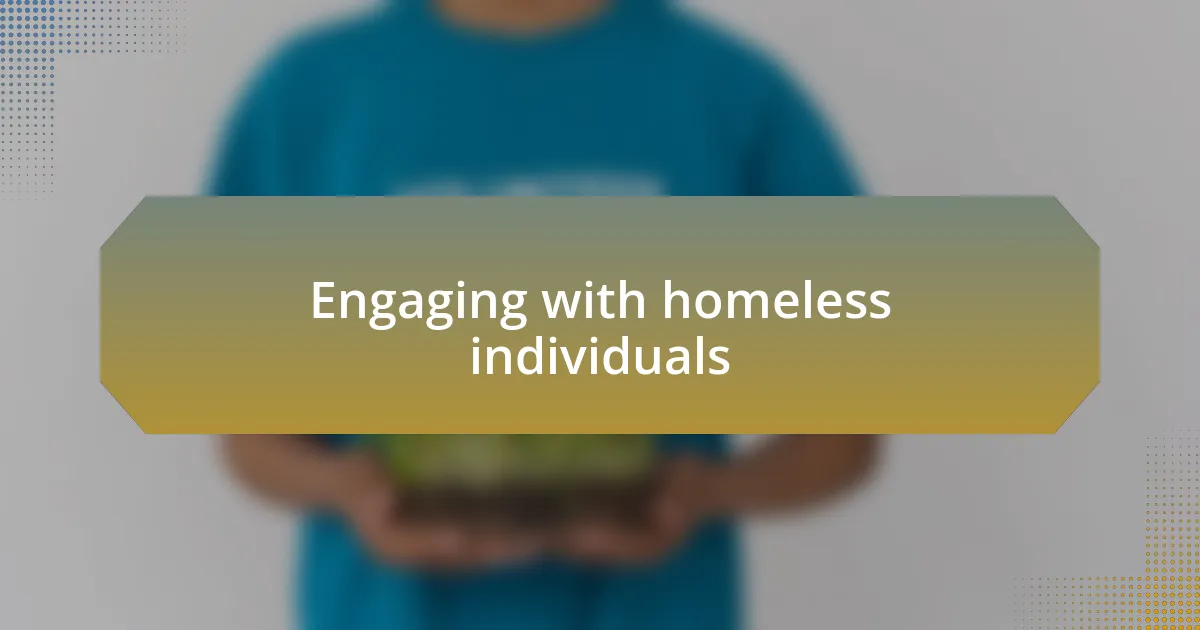
Engaging with homeless individuals
Engaging with homeless individuals requires patience and a genuine willingness to understand their stories. I recall one moment that stood out during my time volunteering—a man named Tom who seemed reluctant to speak. One afternoon, I took a seat beside him and simply listened as he shared snippets of his life. As I showed interest without judgment, the conversation flowed more easily, revealing a depth of resilience I hadn’t anticipated. Have you ever tried just listening to someone without trying to fix their problems? Sometimes, that’s what individuals need most.
Creating an inviting atmosphere can have a profound impact. I once organized a small game afternoon in the shelter, and to my surprise, it sparked laughter and friendly banter among the residents. That simple act of playing games together transformed how people interacted with each other and me. It made me realize how vital it is to foster a sense of belonging in these spaces. Through play, barriers melted away, and we found shared joy in our humanity.
Understanding that every interaction is a chance to connect on a deeper level shifted my perspective entirely. I remember conversing with a woman named Sarah, who initially kept to herself, but as we talked about art, her eyes lit up with passion. We discovered a common love for painting, and suddenly, she opened up about her dreams and struggles. Have you considered how shared interests could bridge gaps? Those connections not only enrich our own lives but also uplift the spirits of those we aim to support.
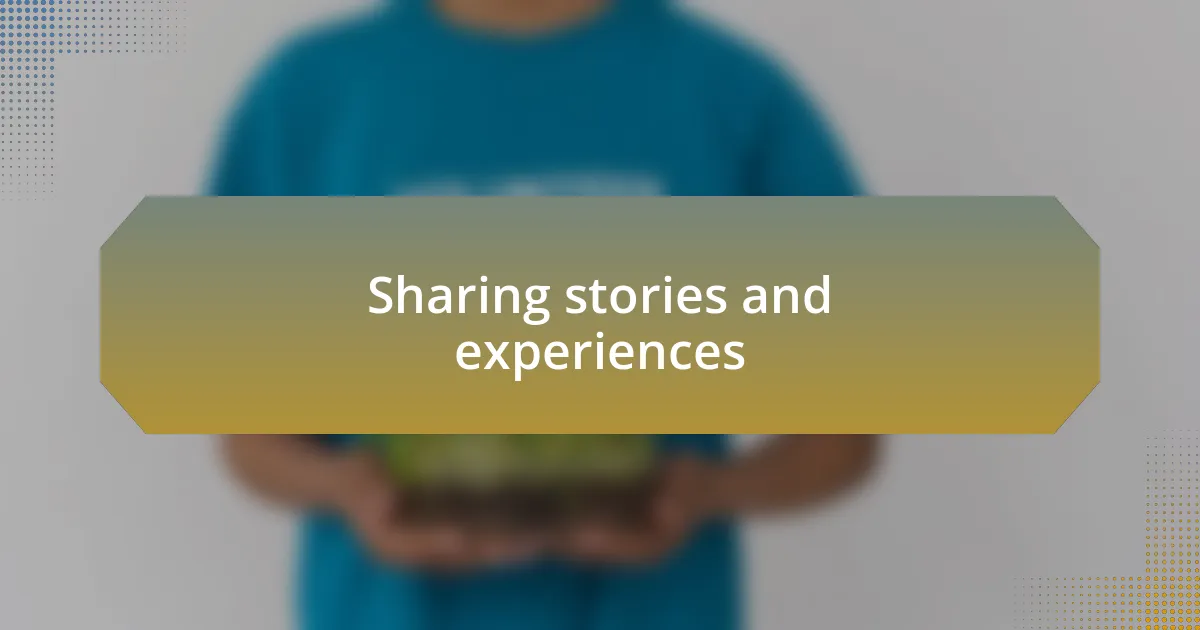
Sharing stories and experiences
Sharing stories has an incredible way of building bridges. I remember one chilly evening when I met Maria, a talented storyteller whose words painted vivid pictures of her past. As she recounted her childhood, I felt a profound connection forming—her tales of happiness and heartbreak resonated deeply within me. Have you ever realized how powerful it is when someone feels safe enough to share their most intimate memories? It’s as if we momentarily stepped outside of our circumstances and simply connected as human beings.
One afternoon, we arranged a “story circle” at the shelter. Residents gathered, each eager to share their experiences. Some were humorous, others heartbreaking, but each story was raw and real. Hearing someone else’s truth can be a touchstone, reminding us that we are part of something larger than ourselves. I was struck by how these narratives offered solace and validation, encouraging everyone to embrace their journey, no matter how difficult it may be. It made me wonder: why do we often shy away from sharing our stories when they can heal and inspire?
What surprised me most was the unexpected influx of empathy that followed our story-sharing sessions. I noticed shifts in the participants’ interactions, where compassion replaced indifference. There was one remarkable moment when a younger resident openly shared his struggles with addiction, prompting others to open up about their own battles. In that space, I witnessed a transformation—not just within individuals, but within the entire community. Have you ever observed how vulnerability can unite people in ways nothing else can? Those shared experiences, brilliant in their authenticity, helped solidify connections that could lead to lasting friendships and support networks.